At the Second Annual Conference for Nabataean Studies, Dr. Bilal Khrisat of the Hashemite University presented a paper that introduced the conference to the various board games that are found in ancient Petra. That paper also introduced us, (nabataea.net) to this fascinating aspect about Petra. In response to Dr. Khrisat’s studies, we here at Nabataea.net have started to search through Petra and other Nabataean sites to learn about these games and try and find how they were played. In order to do this, we first did some basic research into ancient games, so we would be better informed about what we might be looking at as we searched Nabataean sites. Second, we rounded up several Nabataea.net activists and made several sweeping tours of Petra. Instead of looking up at the marvelous monuments, we kept our heads down, and scoured the ground. It was an exciting activity because game boards started popping up all over the place. Third, we then visited other Nabataean sites to look for board games and fourth, we solicited the help of folk at CanBook’s Game Division. Kenneth Betts, the game logistics expert and others then worked hard at trying to reconcile the game boards we found with what is known about ancient games, to see if we could figure out how they might have been played. The initial results have now been written up in this paper. Many of the pictures we took are found on the web page Petra, City of Board Games.
The Nabataean Game
Throughout Petra and in other Nabataean sites, we discovered that the most common ancient board game was from a game played on a 4 x 12 or in some cases a 4 x 14 playing board. Each of the playing spots was actually a small cup carved into the rock. (See below)
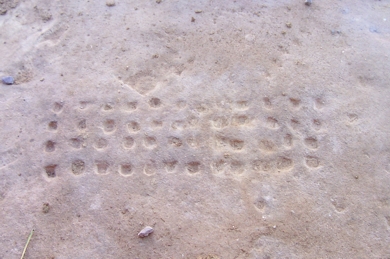
You can see a typical 4 x 12 playing board. This one was found near the Dier monument in Petra, and is typical of the most common type of game in ancient Petra. Other game boards included: 7 x 7 and 7 x 8 layouts as well as 8 x 14.
For more pictures, see Petra: City of Board Games. As we researched these game boards, several suggestions were made as to what they could have been.
Mancala
Mancala has its origins in either Africa or the Arab world, depending on which scholar’s theory you choose to believe. Some of the oldest evidence is found in the National Geographic sponsored archaeological diggings that searched back to 7,000 to 5,000 BC in present-day Jordan. Excavations of an ancient house uncovered a limestone slab with two parallel rows of circular depressions. The layout was easily recognizable to an archaeologist on the dig as a Mancala playing board. Murray, a noted scholar, traced the origins to ancient Egypt’s Empire Age (about the 15th to 11th centuries BC). Many experts surmise that Mancala may in fact be the oldest board game ever.
The earliest recorded writings describing the game were found in references to mancala in Arab religious texts dating to the Middle Ages. Some scholars believe that the game originated in the Middle East and spread from there to Africa. Then, the game spread to Asia with Arab traders and much later came to the Caribbean around 1640 via the African slave trade. Other experts try and place the origins in Central Africa.

A traditional Mancala board found in Asia. They can be anywhere from 2 x 8 to 2 x 12, and usually have a bin on either end.
Picture above used from the Expat Web Site Association
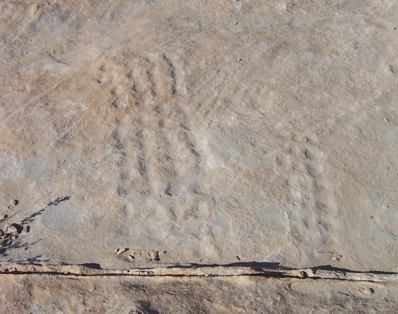
Two game boards found in Petra. On the right is a more traditional Mancala type board, but appears to have three rows of cups. On the left is a second game: a Nabataean 4 x 12 game board.
Today, Mancala is known by numerous names around the world. These names are taken from the local culture, using words that reflect where the game is played, the manner of winning, the mode of play and the board or counters used. In English it is often referred to as Count and Capture.
In some West African countries the depressions in the board are referred to as Warri or Awari, which means houses, thus giving the game the name Wari. In Nigeria the game is known as Adi, which is the name of the seeds used to play the game.
In our survey for ancient game boards in Petra we found many game boards with small hollow cups that most likely served for playing games of the Mancala family. These games used no dice but relied entirely on counting and computing.
Mancala boards come in many different sizes. One Mancala board in the British Museum has four rows of 26 hollows each, plus two larger bins at each narrow end. Most of the others with four rows are eight cups long, but other variants exist. The configuration with only two rows is a very popular Mancala version among present day Bedouin Arabs.
For more on Mancala boards, see “Mancala Board Games” by Alexander J. De Voogt, British Museum Press, 1997, (see page 23 for the above 4 x 26 board). Also consult recoveredscience.com (e-books on riddles in science, easy to read and hard to forget) by H. Peter Aleff.
Other Games of the Mancala Family
Over the centuries other games have been developed from Mancala. The game Olinda Kaliya (right) is from Shri Lanka. It has seven cups plus two bins at each end. The cups are large and the movers are very small.
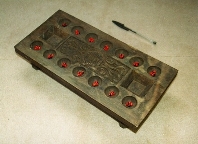
The picture of Olinda Kaliya on the left has been taken from The Online Guide to Traditional Games Used with permission.
The Online Guide to Traditional Games
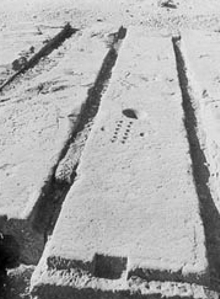
The Temple of Seti I game
Ancient Egyptian Version
A game board similar to Mancala was found on the roof of the temple of Seti I in Egypt. The Temple of Seti I was completed by Ramses II for his father, Seti I, likely within the first 5 years of his reign. It was used as part of the Abydene pilgrimages for over 1000 years, and was eventually closed down during the Roman period. Since roofs of temples were often used by priests to observe the stars, they would spend hours in these locations. When waiting for the stars to come out, or for the sky to clear, they apparently played games. There are numerous game boards are hollowed out in the sandstone blocks of the temple.
Omweso
Omweso is a Mancala type game from Uganda, with 4 rows. Note that the seeds are small, and the holes are large, in order to accommodate a large number of seeds, which could accumulate to more than twenty in a spot. The picture of Omweso on the right was been taken from The Online Guide to Traditional Games. Used with permission.
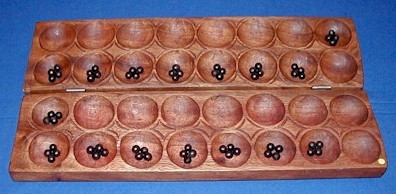
Omweso is a Mancala type game from Uganda, with 4 rows. Note that the seeds are small, and the holes are large, in order to accommodate a large number of seeds, which could accumulate to more than twenty in a spot. The picture of Omweso on the right was been taken from The Online Guide to Traditional Games. Used with permission.
The Online Guide to Traditional Games
Bao

Bao is a similar game played in East Africa. It also uses large cups and bins on each end.
This picture of Bao was been taken from The Online Guide to Traditional Games. Used with permission.
There are several problems with trying to classify the Nabataean boards as a variant of the Mancala game. First, Petra’s game boards are a puzzling 4 x 12 or 4 x 14 holes. They have no bins at the end, making them different from other games in the Mancala family. Second, they have very small holes. As the pictures above illustrate, Mancala requires large holes, in case they have to hold a large number of counters. If the board is 2 x 8, then the number of counters is quite limited. However, if the board becomes longer, the number of counters rises dramatically. Game designer and logistics expert, Ken Betts, tried several variations of Mancala, including placing movers in every second hole, but no matter what configuration was used, the spaced needed to contain many movers. In the end he concluded that it seems very unlikely that the Nabataean boards were any known variation of the Mancala game. So our search continued.
Seega
The ancient game of Seega has been played for centuries throughout Egypt and other parts of the Middle East. It is a simple game in terms of materials and rules, but it involves plenty of strategy and thinking once you are playing. In Egypt, 5x5 game boards were common, while 7 x 7 or 9 x 9 board do exist. The larger boards are more complex, and created a greater challenge for the players. Does the presence of 7 x 7 boards indicate a Nabataean preference for challenges? The game of Seega requires only one mover per location, so the holes do not have to be large. It is very possible that Petra’s square game boards that are 5, 7, or 9 places square are Seega boards. For an overview of the rules, and links to sites on the Internet about Seega, click here.
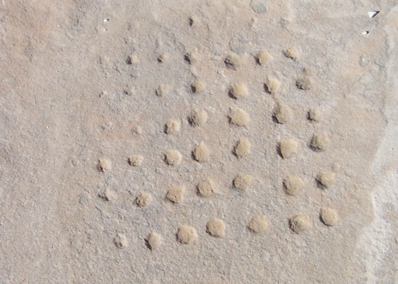
A board of 5 x 5 squares is marked out and each player has twelve distinctive 'stones'.
Rocks and potsherds work nicely. If the board is increased to 7 x 7 or 9 x 9, each the players would have twenty-four or forty pieces. So, it is very possible that the square boards are Seega Board.
While this explains the 5, 7, and 9 place square game boards, it still does not explain the others, especially the 4 x 12 or 14 boards.
The Royal Game of Ur
The most famous of the ‘Royal Game of Ur’ boards was found by Sir Leonard Woolley in 1927 in the tomb of a nameless king of Ur, where it had been either abandoned or overlooked by robbers looking for more lucrative spoil. It was hollow to allow a place for storing the pieces. It is made of fine inlays of shell, bone, lapis lazuli, and red limestone. The board dates from about 2500 BC, and was one of five such boards (albeit the most richly decorated one) found by the famous archaeologist in various tombs of the royal cemetery of Ur.

The Royal Game of Ur' is the most ancient board game known
‘The Royal Game of Ur’ is the most ancient board game known, predating even Egyptian Senet by about 300 years. It appears to have been very popular among the Sumerian rulers and to have spread from Sumer to sites all over the ancient world from India to the Mediterranean. The ancient Egyptian game ‘20-Squares’ (dating from about 1800 BC), for instance, is very likely a version of this game. ‘The Royal Game of Ur’ was played in ancient Sumer and Mesopotamia since before at least 2500 BC. ‘The Royal Game of Ur’ is of course not the game’s real name, as its actual name is lost in antiquity, but because of the examples of it found in the royal cemetery of Ur, the game soon came to be called ‘The Royal Game of Ur’ among archaeologists. The game is played with fourteen markers (seven to a side) with two sets, one for each player, of three curious pyramidal dice. The boards the markers move on are variously made but all share distinct rosette markings on strategic squares. While this is an interesting game, it doesn’t seem to be similar to anything we found in Petra. Istructions for this game can be found at: http://www.iranica.com/articles/board-games-in-pre-islamic-persia
Senet
Senet was an immensely popular game in ancient Egypt, and was played by both commoners and nobility. In later times it even seems to have taken on religious significance.
The game was played on a board of 30 squares; the object being to get one’s pieces on the board, then around the board in an S-shaped pattern, and finally off again at the far end. The game required strategy as well as chance. The most common playing pieces were 5 cones shaped pieces pitted against 5 reel shaped pieces (These pieces were called ‘ibau’ which means ‘dancers’ in Egyptian). Senet was originally a two player game but during the New Kingdom period a game in progress would often appear painted on tomb walls as a ‘one’ player game, the opponent being a spirit from the afterlife.
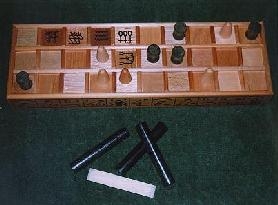
A modern version of Senet
This picture is a modern version of Senet, from The Online Guide to Traditional Games. Used with permission.
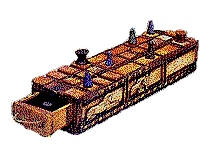
This Senet board came from the tomb of Ak-Hor at Dra abu el-Naga on the West Bank of Thebes. The game box is made of ebony and ivory, and the playing pieces are made of faience, a composite material of ground quartz with a colored, alkaline glaze.
For the rules for Senet and links to Internet sites about the game click here.

The 4 x 12 game boards in Petra could easily be some sort of Senet boards. The players basically rolled a dice, or cast sticks (see rules), and moved their pieces onto the board, and tried to race them to the end. If they landed on another player's piece, they could 'bump' him off of the board. The players generally moved in an S shaped direction

Examples of 3 x 12 Senet boards were also common in Egypt. However, in our search for game boards in Petra, we did not turn up any traditional Senet game boards. If the 4 x 12 or 4 x 10 game boards that we did locate were Senet games, then they would have had to be played as illustrated on the left. While this is an acceptable solution, it does seems to be just prolonging an already simple game.

4 x 23 It would be even longer if played on a 4 x 23 or 4 x 24 board. (Yes, at least one of these boards was found in Petra by Dr. Bilal Khrisat). Left: A 4 x 23 game board. (Illustrating one found in Petra)
Twenty Squares

An ancient 20 squares board, and assorted casting sticks, dating from the 18th dynasty of Egypt. The playing pieces are blue faience.
The playing pieces are blue faience. This game was played very much like Senet (sometimes called 30-squares) and since we do not know the name of this ancient game we can only refer to as ‘The twenty squares game’. Some years ago, earlier in the last century, due to a misunderstanding, Egyptologists thought it to be called ‘Tjau’ (which means ‘robbers’).
20-Squares is often found on the reverse side of the ancient Senet boards and both games used the same pieces, although they are really quite different games. There is strong evidence that 20-Squares is not originally of Egyptian origin but instead ‘invaded’ Egypt from Assyria. It is most likely related to the ‘Royal game of Ur’ and may in fact be the same game (there are similarities in the board and board markings). In any case, 20-Squares became a distinctively Egyptian game and extremely popular in ancient Egypt from the period of around 3000 B.C. to 400 A.D. If 20-Squares is a form of the ‘Royal game of Ur’, it may pre-date even Senet by 300 or more years.
The game was played on a board of, naturally, 20 squares; the object being to get one’s pieces on the board, then move in a diagonal pattern around and down the central row of squares, and finally off the far end. The game requires some strategy, and a lot of chance. The ‘chance’ comes from ‘casting sticks’, used as ‘dice’ in older times. The most common playing pieces were 5 cones shaped pieces pitted against 5 reel shaped pieces (These pieces were called ‘ibau’ which means ‘dancers’ in Egyptian). 20-Squares was definitely played in Egypt for more than 3000 years. When Howard Carter open Tutankhamun’s tomb he found four Senet boards, two of which were jumbled up and scattered, along with many other articles, by thieves in the distant past. One of these Senet boards is shown (circled), just as it was found.

On the other side of this board (hidden from our view in this picture) is, you guessed it, a 20-Squares board. Note: Some of the ‘Reel’ and ‘Cone’ playing pieces were never found and it is assumed that they were made of silver and gold and were thus were prime targets for thieves.Unfortunately, there are no game boards in Petra that resemble the 20 squares board. While this is interesting to know about, we have not be able to link the 20 squares game to anything found within Nabataea. On the other hand, it does illustrate that Senet type games could be shortened for faster play, but it doesn’t lead us to believe that a larger board was in anyway appreciated.
Quirkat
Quirkat is a game of strategy that pits 2 armies of 12 men each, on a 5 X 5grid. It may be of ancient Egyptian origin, but first became known in the west when it came across the straits with Tariq’s conquering Arab and Berber army in 711 A.D. and spread from Spain to Europe.
It is first mentioned in written history somewhere in the 20 volumes of the Kitab al-Aghani (book of songs) which is poetic anthology on medieval Islamic society written by Abu al-Faraj Ali of Esfahan around 950 AD. Alphonso X recorded an (incomplete) set of rules and provided and illumination in his ‘Libro de Acedrex, Dados e Tablas’, a magnificently illuminated manuscript compiled between 1251 and 1282 AD).
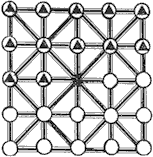
Sometime later, around 1100, possibly in the South of France, somebody decided to play Quirkat on a chess board instead of the standard board. The game was played with 12 pieces on each side and was called Fierges or Ferses at first although this changed to Dames later. The game did not force a player to take enemy pieces when the opportunity presented itself.
The compulsory rule forcing a player to take whenever possible was introduced in France around 1535, the resulting new game being called Jeu Force. At this point the old game became known as Le Jeu Plaisant De Dames or Plaisant for short.
The first book written on the game was published in Valencia, Spain in 1547 and now resides in the Royal Library of Madrid. Jeu Force is the game played in England today under the name of Draughts and the game was taken to America and called Checkers. The first book in English about it was written in 1756 by Wiliam Payne, a mathematician from London.
The rest of Europe took to playing a different development of Le Jeu Plaisant De Dames which appeared in Paris in 1727 and which is now the internationally recognized game of Polish or Continental Draughts. This game is superior in complexity to English draughts (or checkers) by virtue of the fact that it is played on a board ten squares by ten squares.
When researching this, we began to wonder if the 7 x 7 boards in Petra were Seega boards or large Quirkat boards. Since the Europeans expanded the board to 10 x 10, could the Nabataeans not have played the same game on a 7 x 7 board? In that case, a 7 x 7 board could be used for both Quirkat or Seega.
Labyrinths
In his report to the Second Annual Conference for Nabataean Studies, Dr. Bilal Khrisat mentioned that he had found Labyrinth symbols in Petra. This symbol has been used for many centuries, and is found in many different locations around the world. No one knows of its origin, it’s meaning, nor why it was transported and adopted by so many different people around the world. There was an ancient building, known as The Labyrinth. It was a Minoan palace/temple complex that was destroyed several times during its long history, but was finally abandoned around1380 BC. Interestingly, no examples of the labyrinth symbol have survived from the original site.
The symbol right is a typical Labyrinth symbol as found in antiquity. No one knows if it was connected with the ancient Labyrinth temple. During the last few years, a growing number of websites have begun that focus on the Labyrinth symbol. Most of them are ‘New Age sites’ that try and attach some mystic or spiritual experience with the design. A small number of these sites also mention some of the historical and archeological background behind this symbol. You can read more about labyrinths by following the links on this page. Some of the ancient places around the world that this symbol has shown up are listed below. The pictures of labryinths below are taken from Caerdronia. (Used without permission)
The earliest examples of labyrinths, for which an accurate date can be ascribed are to be found around the shores of the Mediterranean. A labyrinth-inscribed clay tablet from Pylos, Greece is over 3200 years old; a similar date applies to labyrinths on pottery fragments from Syria. (right)
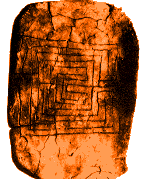
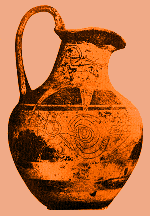
The depiction of the labyrinth on a wine jar from Tragliatella dates to the 7th century BC; it shows armed soldiers on horseback running from a labyrinth with the word Truia (Troy) inscribed in the outermost circuit. (left)
The famous labyrinth decorated coins from Knossos, Crete, date from the last three centuries before Christ. (right) Their designs are thought to allude to the legendary Labyrinth at Knossos in which the Minotaur was imprisoned.

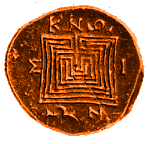
The labyrinth symbol was widely used and adapted by the Romans; its geometric form was a popular subject for depiction in mosaic pavements as over sixty known examples attest. They are found throughout the Roman empire from Britain to Yugoslavia and in north Africa. The designs used are quite different from the classical labyrinth, but in fact a simple development from it.
In the Americas, the labyrinth symbol has been found etched into the sands of the Nazca Plain in Peru. It is also in use among the Caduveo people of Brazil, and was scratched on boulders and rockfaces in Northern Mexico, New Mexico and Arizona many years ago. It is also a known symbol among the Hopi Indians. These are all places that our readers have hypothesized that Nabataeans sailors may have reached in their travels.

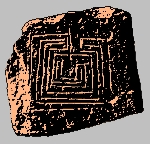
In the Americas, the labyrinth symbol has been found etched into the sands of the Nazca Plain in Peru.
It is also in use among the Caduveo people of Brazil, and was scratched on boulders and rockfaces in Northern Mexico, New Mexico and Arizona many years ago. It is also a known symbol among the Hopi Indians. These are all places that our readers have hypothesized that Nabataeans sailors may have reached in their travels.
Strange and Stranger Game Boards from Petra
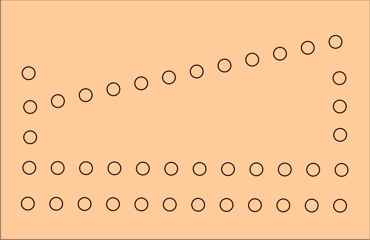
Just when we think we have an explanation for all of the game boards in Petra, up pops a board like the one on the right. Go and figure!
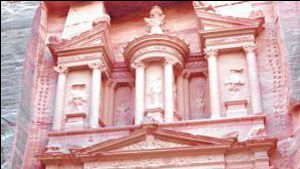
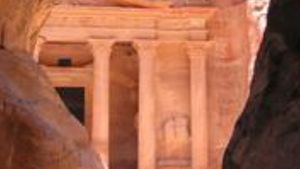
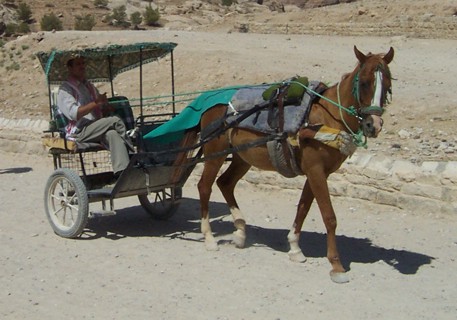
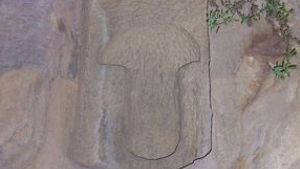
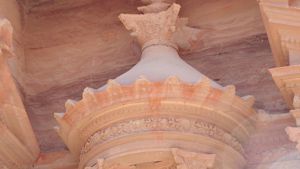

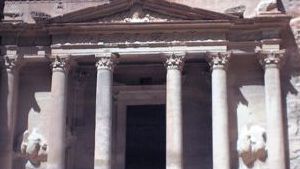
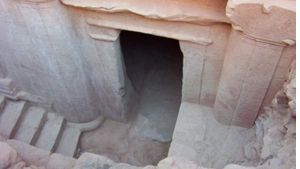
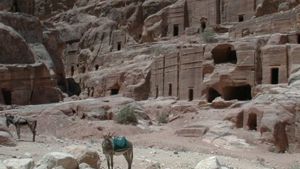

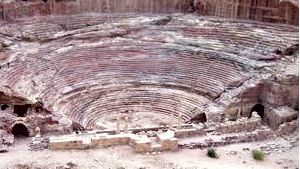

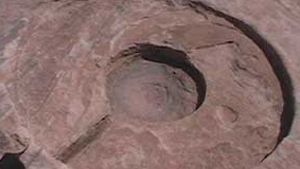
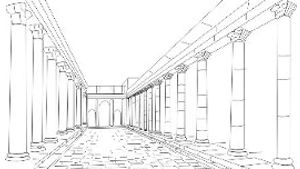

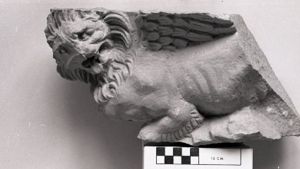

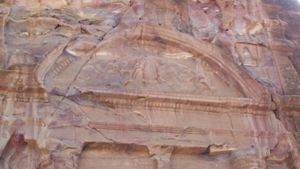
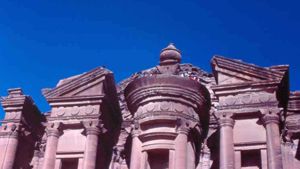
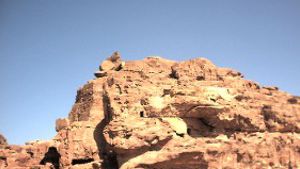
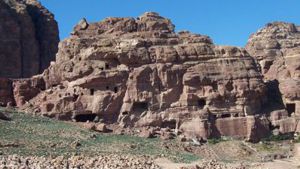
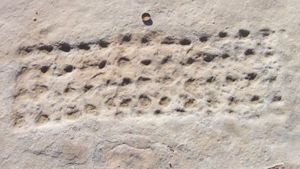
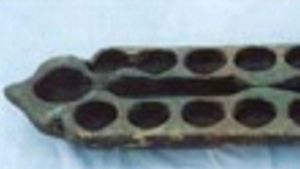

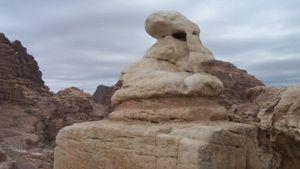
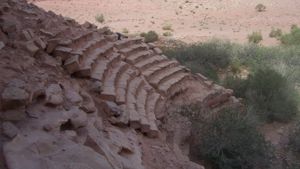
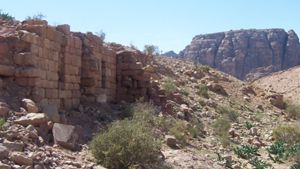

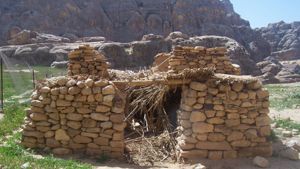

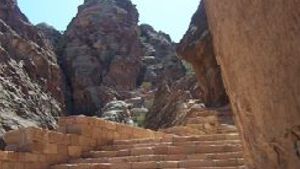

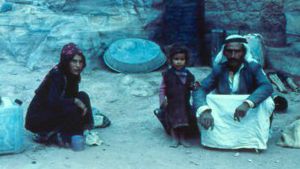
Page Discussion
Membership is required to comment. Membership is free of charge and available to everyone over the age of 16. Just click SignUp, or make a comment below. You will need a user name and a password. The system will automatically send a code to your email address. It should arrive in a few minutes. Enter the code, and you are finished.
Members who post adverts or use inappropriate language or make disrespectful comments will have their membership removed and be barred from the site. By becoming a member you agree to our Terms of Use and our Privacy, Cookies & Ad Policies. Remember that we will never, under any circumstances, sell or give your email address or private information to anyone unless required by law. Please keep your comments on topic. Thanks!